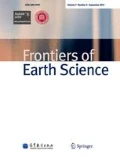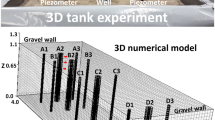Abstract
The influence of shallow groundwater on the diurnal heat transport of the soil profile was analyzed using a soil sensor automatic monitoring system that continuously measures temperature and water content of soil profiles to simulate heat transport based on the Philip and de Vries (PDV) model. Three experiments were conducted to measure soil properties at depths of 5 cm, 10 cm, 20 cm, and 30 cm when groundwater tables reached 10 cm, 30 cm, and 60 cm (Experiments I, II, and III). Results show that both the soil temperature near shallow groundwater and the soil water content were effectively simulated by the PDV model. The root mean square errors of the temperature at depths of 5 cm, 10 cm, and 20 cm were 1.018°C, 0.909°C, and 0.255°C, respectively. The total heat flux generated the convergent and divergent planes in space-time fields with valley values of–161.5W•m–2 at 7:30 and–234.6W•m–2 at 11:10 in Experiments II and III, respectively. The diurnal heat transport of the saturated soil occurred in five stages, while that of saturated-unsaturated and unsaturated soil profiles occurred in four stages because high moisture content led to high thermal conductivity, which hastened the heat transport.
Similar content being viewed by others
References
Bittelli M, Ventura F, Campbell G S, Snyder R L, Gallegati F, Pisa P R (2008). Coupling of heat, water vapor, and liquid water fluxes to compute evaporation in bare soils. J Hydrol (Amst), 362(3–4): 191–205
Brutsaert W (1982). Evaporation into the atmosphere: theory, history, and applications. Dordrecht: D. Reidel Publ.
Cahill A T, Parlange M B (1998). On water vapor transport in field soils. Water Resour Res, 34(4): 731–739
Camillo P J, Gurney R J (1986). A resistance parameter for bare-soil evaporation models. Soil Sci, 141(2): 95–105
Campbell G S (1977). An Introduction to Environmental Biophysics. New York: Springer-Verlag
Campbell G S (1985). Soil Physics with Basic, Transport Models for Soil-Plant Systems. Amsterdam: Elsevier
Campbell G S, Norman J M (1998). An Introduction to Environmental Biophysics (2nd edition). New York: Springer-Verlag
Cass A, Campbell G S, Jones T L (1984). Enhancement of thermal water vapor diffusion in soil. Soil Sci Soc Am J, 48(1): 25–32
Chen S H, Su H B, Zhan J Y (2014). Estimating the impact of land use change on surface energy partition based on the Noah model. Front Earth Sci, 8(1): 18–31
Corbari C, Mancini M, Li J, Su Z (2015). Can satellite land surface temperature data be used similarly to ground discharge measurements for distributed hydrological model calibration? Hydrological Sciences Journal, 60(2): 202–217
de Vries D A (1958). Simultaneous transfer of heat and moisture in porous media. Trans Am Geophys Union, 39(5): 909–916
de Vries D A (1963). The thermal properties of soils. In: van Wijk W R, ed. Physica of Plant Environment. Amsterdam: North-Holland Pub. Co, 210–235
Deb S K, Shukla M K, Sharma P, Mexal J G (2011). Coupled liquid water, water vapor, and heat transport simulations in an unsaturated zone of a sandy loam field. Soil Sci, 176(8): 387–398
Fan Z, Nefa J C, Harden J W, Zhang T, Veldhuis H, Czimczik C I, Winston G C, O'Donnell J A (2011). Water and heat transport in boreal soils: implications for soil response to climate change. Sci Total Environ, 409(10): 1836–1842
Gran M, Carrera J, Massana J, SaaltinkMW, Olivella S, Ayora C, Lloret A (2011). Dynamics of water vapor flux and water separation processes during evaporation from a salty dry soil. J Hydrol (Amst), 396(3–4): 215–220
Gregory J M, Peterson R E, Lee J A, Wilson G R (1994). Modeling wind and relative humidity effects on air quality. In: International Conferences on Air Pollution from Agricultural Operations. Midwest Plan Service Ames IA, 183–190
Grifoll J, Gastó J M, Cohen Y (2005). Non-isothermal soil water transport and evaporation. Adv Water Resour, 28(11): 1254–1266
Idso S B (1981). A set of equations for full spectrum and 8- to 14-µm and 10.5- to 12.5-µm thermal radiation from cloudless skies. Water Resour Res, 17(2): 295–304
Jabro J D (2009). Water vapor diffusion through soil as affected by temperature and aggregate size. Transp Porous Media, 77(3): 417–428
Kane D L, Hinkel K M, Goering D J, Hinzman L, Outcalt S I (2001). Non-conductive heat transfer associated with frozen soils. Global Planet Change, 29(3–4): 275–292
Laredj N, Missoum H, Bendani K, Maliki M (2012). A coupled model for heating and hydratation in unsaturated clays. Arab J Geosci, 5(5): 935–942
Lu S, Ren T, Yu Z, Horton R (2011). A method to estimate the water vapour enhancement factor in soil. Eur J Soil Sci, 62(4): 498–504
Milly P C (1982). Moisture and heat transport in hysteretic, inhomogeneous porous media: a matric head-based formulation and a numerical model. Water Resour Res, 18(3): 489–498
Monteith J L, Unsworth M H (1990). Principles of Environmental Physics. London: Edward Arnold
Mualem Y (1976). A new model for predicting the hydraulic conductivity of unsaturated porous media. Water Resour Res, 12 (3): 513–522
Nassar I N, Horton R (1997). Heat, water, and solute transfer in unsaturated porous media: I–theory development and transport coefficient evaluation. Transp Porous Media, 27(1): 17–38
Nassar I N, Horton R (1999). Salinity and compaction effects on soil water evaporation and water and solute distributions. Soil Sci Soc Am J, 63(4): 752–758
Nimmo J R, Miller E E (1986). The temperature dependence of isothermal moisture vs. potential characteristics of soils. Soil Sci Soc Am J, 50(5): 1105–1113
Noborio K, McInnes K J, Heilman J L (1996). Two-dimensional model for water, heat, and solute transport in furrow-irrigated soil: I. Theory. Soil Sci Soc Am J, 60(4): 1001–1009
Novak M D (2010). Dynamics of the near-surface evaporation zone and corresponding effects on the surface energy balance of a drying bare soil. Agric Meteorol, 150(10): 1358–1365
Philip J R, de Vries V D (1957). Moisture movement in porous materials under temperature gradient. Trans Am Geophys Union, 38(2): 222–232
Prunty L, Bell J (2005). Soil temperature change over time during infiltration. Soil Sci Soc Am J, 69(3): 766–775
Saito H, Šimunek J (2009). Effects of meteorological models on the solution of the surface energy balance and soil temperature variations in bare soils. J Hydrol (Amst), 373(3–4): 545–561
Saito H, Šimunek J, Mohanty B P (2006). Numerical analysis of coupled water, vapor, and heat transport in the Vadose Zone. Vadose Zone J, 5 (2): 784–800
Schaefli B, van der Ent R J, Woods R, Savenije H H G (2012). An analytical model for soil-atmosphere feedback. Hydrol Earth Syst Sci, 16(7): 1863–1878
van Bavel C H M, Hillel D I (1976). Calculating potential and actual evaporation from a bare soil surface by simulation of concurrent flow of water and heat. Agric Meteorol, 17(6): 453–476
van Genuchten M Th (1980). A closed-form equation for predicting the hydraulic conductivity of unsaturated soils. Soil Sci Soc Am J, 44(5): 892–898
Wang D (2002). Dynamics of soil water and temperature in aboveground sand cultures used for screening plant salt tolerance. Soil Sci Soc Am J, 66(5): 1484–1491
Webb E K (1970). Profile relationships: the log-linear range, and extension to strong stability. Q J R Meteorol Soc, 96(407): 67–90
Zeller K F, Nikolov N T (2000). Quantifying simulations fluxes of ozone, carbon dioxide and water vapor above a subalpine forest ecosystem. Environ Pollut, 107(1): 1–20
Zeng Y, Su Z, Wan L, Wen J (2011). A simulation analysis of the advective effect on evaporation using a two-phase heat and mass flow model. Water Resour Res, 47(10): W10529
Zeng Y, Wan L, Su Z, Saito H, Huang K, Wang X (2009). Diurnal soil water dynamics in the shallow vadose zone (field site of China University of Geosciences, China). Environmental Geology, 58(1): 11–23
Author information
Authors and Affiliations
Corresponding author
Rights and permissions
About this article
Cite this article
Jiang, J., Zhao, L. & Zhai, Z. Estimating the effect of shallow groundwater on diurnal heat transport in a vadose zone. Front. Earth Sci. 10, 513–526 (2016). https://doi.org/10.1007/s11707-015-0524-5
Received:
Accepted:
Published:
Issue Date:
DOI: https://doi.org/10.1007/s11707-015-0524-5



